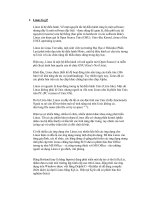Lecture An toàn Hệ điều hành: OS Vulnerabilities - Nguyễn Hồng Sơn
Bạn đang xem bản rút gọn của tài liệu. Xem và tải ngay bản đầy đủ của tài liệu tại đây (2.32 MB, 36 trang )
OS Vulnerabilities
1
Background
A process' address space is divided into four
"segments"
2
3
4
5
Buffer Overflows
A buffer overflow is a weakness in code where the
bounds of an array (often a buffer) can be exceeded.
An
attacker will be able to write over other data in
memory and cause the code to do something it wasn't
supposed to
Generally, this means that an attacker could coerce a
program into executing arbitrary code of the attacker's
choice.
6
Buffer Overflow: Stack Smashing
The buffer being overflowed is located in the stack. In
other words, the buffer is a local variable in the code.
As the stack-allocated buffer is filled from low to high
memory, an attacker can continue writing, right over top of
the return address on the stack
7
…
If an attacker controls the exploited program's environment, they can put their
shellcode into an environment variable.
Instead of making the new return address point to the overwritten buffer, the
attacker points the new return address to the environment variable's memory
location
8
Buffer Overflow: Frame Pointer
Overwriting
The attack overwrites a byte of the saved frame
pointer
When the called subroutine returns, it restores the
saved frame pointer from the stack; the caller's code
will then use that frame pointer value.
After a frame pointer attack, the caller will have a
distorted view of where its stack frame is.
9
10
Buffer Overflow: Returns into Libraries
If an attacker can't run arbitrary code, they can still run other
code
Shared library code
An attacker can overwrite a return address on the stack to point
to a shared library routine to execute
For example, an attacker may call the system library routine,
which runs an arbitrary command.
Arguments may be passed to library routines by the attacker by
writing beyond the return address in the stack
11
12
Buffer Overflow: Heap Overflows
A heap overflow is a buffer overflow, where the buffer is located in the heap
or the data segment
The idea is not to overwrite the return address or the saved frame pointer,
but to overwrite other variables that are adjacent to the buffer.
character buffer[123]
function pointer p
Overflowing the buffer allows an attacker to change the value of the
function pointer p, which is the address of a function to call
If the program performs a function call using p later, then it jumps to the
address the attacker specified; again, this allows an attacker to run arbitrary
13
code.
Buffer Overflow: Memory Allocator
Attacks
One way heap overflows can be used is to attack the dynamic
memory allocator
The allocator needs to maintain bookkeeping information
for each block of memory that it oversees in the heap
When a program requests an X-byte block of memory, the
allocator reserves extra space:
• Before the block, room for bookkeeping information.
• After the block, space may be needed to round the block size up
Exploiting a heap overflow in one block allows the
bookkeeping information for the following block to be
14
overwritten
15
There are two steps to unlink a node B
16
An attacker exploits a heap overflow in the allocated
block immediately before B, and overwrites B’s list pointers
B's previous pointer is set to the address of the attacker's
shellcode, and B's next pointer is assigned the address of a
code pointer that already exists in the program. For
example, this code pointer may be a return address on the
stack, or a function pointer in the data segment.
The attacker then waits for the program to free the memory
block it overflowed
17
18
Integer Overflows
In most programming languages, numbers do not have infinite precision.
For instance, the range of integers may be limited to what can be encoded
in 16 bits
Integer overflows, where a value "wraps around." For example, 30000 +
30000 = -5536.
Sign errors. Mixing signed and unsigned numbers can lead to unexpected
results. The unsigned value 65432 is -104 when stored in a signed variable,
for instance
Truncation errors, when a higher-precision value is stored in a variable with
lower precision. For example, the 32-bit value 8675309 becomes 24557 in
16 bits
19
These effects can be exploited by an attacker - they are collectively called
integer overflow attacks
Usually the attack isn't direct, but uses an integer overflow to cause other types
of weaknesses, like buffer overflows
n = input_number()
size = input_number()
totalsize = n * size
buffer = allocate_memory(totalsize)
i=0
buffer_pointer = buffer
while i < n:
buffer_pointer 0…size-1 = input_N_bytes(size)
buffer_pointer = buffer_pointer + size
20
i-i+1
….
If an attacker's input results in n being 1234 and size
being 56, their product is 69104, which doesn't fit in
16 bits - totalsize is set to 3568 instead.
As a result of the integer overflow, only 3568 bytes of
dynamic memory are allocated, yet the attacker can feed
in 69104 bytes of input in the loop that follows, giving a
heap overflow
21
Format String Vulnerabilities
The format string tells the function how to compose the
arguments into an output string
Depending on the format function, the output string may be
written to a file, the standard output location, or a buffer in
memory
char *s = "is page";
int n = 125;
printf ( "Hello, world!");
printf ( "This %s %d.", s, n ) ;
22
format_string
args
Printf (“so nguyen = %d, chuoi = %s\n”, i, str);
23
24
Example %n
1.
/*format3.c – various format tokens*/
2.
#include "stdio.h"
3.
#include "stdarg.h"
4.
void main (void)
5.
{
6.
char * str;
7.
int i;
8.
str = "fnord fnord";
9.
printf("Str = \"%s\" at %p%n\n ", str, str, &i);
10.
printf("The number of bytes in previous line is %d", i);
11.
25
}









